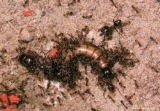
Pheidologeton
Encyclopedia
Pheidologeton is a genus
of ant
s, also called marauder ants, due to their raids similar to those of army ant
s. Their nests are more permanent but almost as large as those of army ants. This genus of ant is recognisable by its dramatic polymorphism
, the difference in sizes of the worker caste
s; there is a super-major worker in addition to major and minor.
There are about 42 species
/subspecies in this genus. They range from Africa
through south Asia
into Australia
.
Two fossil
species are known.
Genus
In biology, a genus is a low-level taxonomic rank used in the biological classification of living and fossil organisms, which is an example of definition by genus and differentia...
of ant
Ant
Ants are social insects of the family Formicidae and, along with the related wasps and bees, belong to the order Hymenoptera. Ants evolved from wasp-like ancestors in the mid-Cretaceous period between 110 and 130 million years ago and diversified after the rise of flowering plants. More than...
s, also called marauder ants, due to their raids similar to those of army ant
Army ant
The name army ant is applied to over 200 ant species, in different lineages, due to their aggressive predatory foraging groups, known as "raids", in which huge numbers of ants forage simultaneously over a certain area, attacking prey en masse.Another shared feature is that, unlike most ant...
s. Their nests are more permanent but almost as large as those of army ants. This genus of ant is recognisable by its dramatic polymorphism
Polymorphism (biology)
Polymorphism in biology occurs when two or more clearly different phenotypes exist in the same population of a species — in other words, the occurrence of more than one form or morph...
, the difference in sizes of the worker caste
Caste
Caste is an elaborate and complex social system that combines elements of endogamy, occupation, culture, social class, tribal affiliation and political power. It should not be confused with race or social class, e.g. members of different castes in one society may belong to the same race, as in India...
s; there is a super-major worker in addition to major and minor.
There are about 42 species
Species
In biology, a species is one of the basic units of biological classification and a taxonomic rank. A species is often defined as a group of organisms capable of interbreeding and producing fertile offspring. While in many cases this definition is adequate, more precise or differing measures are...
/subspecies in this genus. They range from Africa
Africa
Africa is the world's second largest and second most populous continent, after Asia. At about 30.2 million km² including adjacent islands, it covers 6% of the Earth's total surface area and 20.4% of the total land area...
through south Asia
South Asia
South Asia, also known as Southern Asia, is the southern region of the Asian continent, which comprises the sub-Himalayan countries and, for some authorities , also includes the adjoining countries to the west and the east...
into Australia
Australia
Australia , officially the Commonwealth of Australia, is a country in the Southern Hemisphere comprising the mainland of the Australian continent, the island of Tasmania, and numerous smaller islands in the Indian and Pacific Oceans. It is the world's sixth-largest country by total area...
.
Two fossil
Fossil
Fossils are the preserved remains or traces of animals , plants, and other organisms from the remote past...
species are known.

